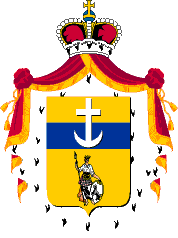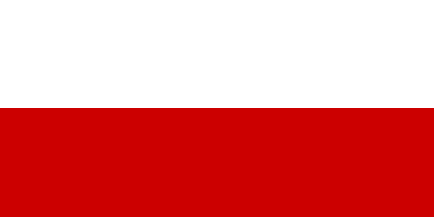 image
by
Mario Fabretto
image
by
Mario Fabretto
Last modified: 2014-04-12 by rob raeside
Keywords: goerz | gradisca | kronland | gorize | landesfarben | austro-hungarian empire |
Links: FOTW homepage |
search |
disclaimer and copyright |
write us |
mirrors
 image by Željko Heimer from FAME
image by Željko Heimer from FAME
Information about Austrohungarian Landesfarben was published in Rosenfeld's
book. Görz und Gradisca is an white over red horizontal bicolour.
Mario Fabretto, 16 September 1996
Concerning Gradisca, could that be 'Gradisce', the Croatian (and
Slovenian) name for the current Burgenland (Burg = Grad)? Could
it be that the old name was transferred to the new Land, with
maybe slightly different boundaries? But of course, present day
Burgenland does not use blue either in its arms or flag. I have
no any idea how old the Landesfärben might be, but I believe that
they could be much older than the flags as we know them. I
believe that various pennons and decorations were used a long
time ago in the colours of the arms. Therefore the use of arms in
Landesfärben as flags wouldn't be unusual, even if not sanctioned
by any law.
Željko Heimer, 15 September 1996
Gradiska: either YBW or WR (3:3). Both flags are heraldically
credible.
Gorize: either WRB or WR or WRYB (1:3:3). All flags credible.
Jan Zrzavy , November 1997
Other sources (incl. Mayers) give one flag for Görz und
Gradisca : white-red.
Željko Heimer , November 1997
Talking about flags, it is very difficult to say which flags (Landesfarben)
were used each time. Coat of arms can help us with some hints but
one cannot get to absolute conclusions. Gradisca had (and has) a
coat of arms "per fess or and azure, a cross surmounting a
crescent argent", so the colours YBW are plausible. They are
reported by G. Pasch but I was never able to know his sources. It
is also difficult to know if these colours were used during the
Eggenberg period or in the period 1717-1754 (and maybe used also
later as local colours). Personally I find quite unprobable the
use of such a tricolor in the 17th century, but I would not be
surprised if ribbons and decorations, even since that time, had
showed the main coat of arms colours. The use of vertical hanging
surely confused who reported local colours, and from this the
great differences among different sources. Also the lack of
official status allowed people to combine the colours in
different ways, not always heraldically correct.
For the County of Gorz, which coat of arms was "per bend,
barred of six argent and gules, azure a lion passant bendwise or",
first reported colours are RYB (L. Philippe, source ?). A
combination of WRYB is plausible but sound quite uncommon for an
Austrian lander. More recent sources reports the colours BY (Plate
published by the Austrian Ministry of public Instruction, 1878,
and Alfred Grenzer: National und Landesfarben von 150 Staates.
1881).
Then we are sure of the WR colours used after 1885 and until 1918;
many photograps and coloured postcards allow this.
Mario Fabretto 23 November 1997
The County of Gorz passed under the Hapsburg in the year 1500
when the last count of the Lurngau dynasty, Leonard, died without
heirs. In the period 1647 - 1717 the town of Gradisca had been
raised to a separate County under the sovereignty of the Counts of
Eggenberg. When this family disappeared (1717) Gradisca remained
until 1754 an Imperial ownership, then was re-unified with Gorz.
In 1861 the Princely Counties of Gorz and Gradisca were
instituted as a Kronland, until 1918 when the Austria-Hungary
Empire disappeared.
In the period between 1754 and 1848, Gorz changed its status many
times:
1747 - 1754: the counties of Gorz and Gradisca are dependent from
the imperial chamber of Lubiana;
1754 - 1783: Gradisca is merged with Gorz and this entity is
ruled by its own "consiglio capitanale";
1783 - 1791: after a short unification with Carniola, a
provincial office was instituted for Gorz, Gradisca and Triest;
1791 - 1797: Gorz is separated from Triest and the "consiglio
capitanale" restored;
1797: French occupation during which Gorz was ruled by a
provisional government;
1797 - 1803: the same as during 1791 - 1797;
1803 - 1805: the counties are transformed in a district under the
govern of Lubiana;
1805 - 1806/7: temporary French government;
1807 - 1809: subdivision of the territory between the Italic
Kingdom and Austria;
1809 - 1813: Gorz is a district of the Illyric Provinces;
1813 - 1816: Creation of the province of Litorale, with Gorz,
Gradisca and Trieste;
1816 - 1848: Litorale is a province of the Kingdom of Illyria;
1848 - 1861: Gorz is a Kronland of Austria;
1861 - 1918: Creation of the princely counties of Gorz and
Gradisca.
Mario Fabretto 23 November 1997
I am sending some images of coat of arms:
Coat of arms of Gradisca, about 1640 - it show also a field with Bellona, goddess of war, granted by Ferdinand II in 1622 to the town, to remember the help given by the women during the siege suffered by the town during the war of 1615-1618. Source: Ink print conserved in the Gorizia civic library;
coat of arms of the Princely Counties of Gorz and Gradisca, 1861-1918. Source: A. Schroll Kunst-Verlag: Stadte-Wappen von Österreich-Ungarn 1885;
coat of arms of the Kingdom of Illiria, 1816-1848. Source:
Archive CISV;
Mario Fabretto 23 November 1997
Regarding the coat of arms of the Kingdom of Illyria, the Austrian formation
is from the post-Napoleonic era, and was not very long lasting. The same arms
are used today as the
arms of the town in Slovenia - Ilirska Bistrica. Though, it seems
that the vessel faces the other way around. The arms are, as is usual
in these parts, applied to the one colour banner in a shield-like
white cartouche with the name of the town inscribed in it. It might be
that the reversal of the vessel is made only on the flag, to make
it vexillologically proper - it faces now to the hoist (or does
it?).
See my pages on http://jagor.srce.hr/~zheimer/flags/descr/si-subil.htm
for the image.
The source is a copy of Banders I received from Jaume Ollé some time
ago According to the same article, the flag was adopted on 18 September 1975.
Željko Heimer , 26 November 1997